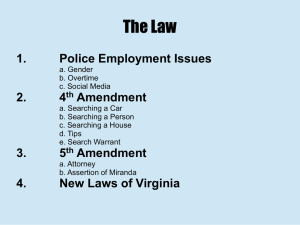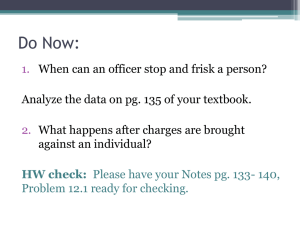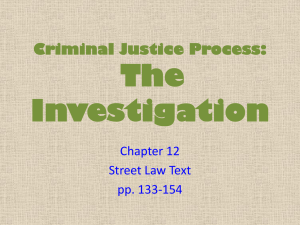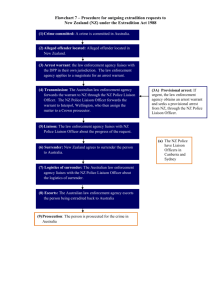Meaning of Criminal Evidence Notes
advertisement
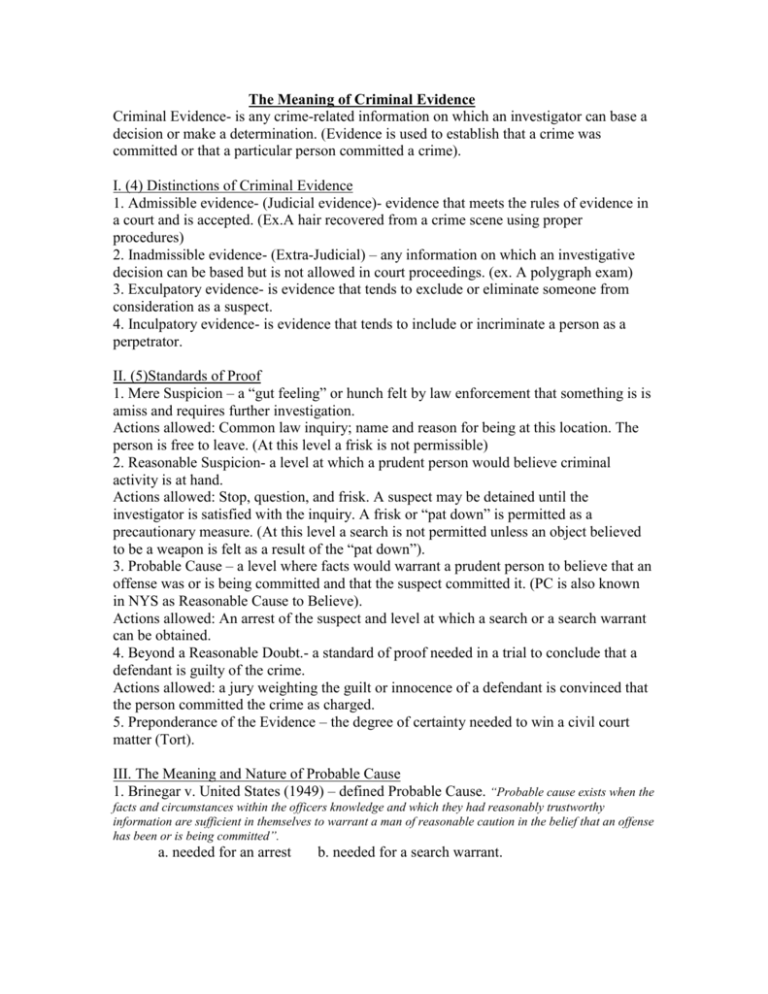
The Meaning of Criminal Evidence Criminal Evidence- is any crime-related information on which an investigator can base a decision or make a determination. (Evidence is used to establish that a crime was committed or that a particular person committed a crime). I. (4) Distinctions of Criminal Evidence 1. Admissible evidence- (Judicial evidence)- evidence that meets the rules of evidence in a court and is accepted. (Ex.A hair recovered from a crime scene using proper procedures) 2. Inadmissible evidence- (Extra-Judicial) – any information on which an investigative decision can be based but is not allowed in court proceedings. (ex. A polygraph exam) 3. Exculpatory evidence- is evidence that tends to exclude or eliminate someone from consideration as a suspect. 4. Inculpatory evidence- is evidence that tends to include or incriminate a person as a perpetrator. II. (5)Standards of Proof 1. Mere Suspicion – a “gut feeling” or hunch felt by law enforcement that something is is amiss and requires further investigation. Actions allowed: Common law inquiry; name and reason for being at this location. The person is free to leave. (At this level a frisk is not permissible) 2. Reasonable Suspicion- a level at which a prudent person would believe criminal activity is at hand. Actions allowed: Stop, question, and frisk. A suspect may be detained until the investigator is satisfied with the inquiry. A frisk or “pat down” is permitted as a precautionary measure. (At this level a search is not permitted unless an object believed to be a weapon is felt as a result of the “pat down”). 3. Probable Cause – a level where facts would warrant a prudent person to believe that an offense was or is being committed and that the suspect committed it. (PC is also known in NYS as Reasonable Cause to Believe). Actions allowed: An arrest of the suspect and level at which a search or a search warrant can be obtained. 4. Beyond a Reasonable Doubt.- a standard of proof needed in a trial to conclude that a defendant is guilty of the crime. Actions allowed: a jury weighting the guilt or innocence of a defendant is convinced that the person committed the crime as charged. 5. Preponderance of the Evidence – the degree of certainty needed to win a civil court matter (Tort). III. The Meaning and Nature of Probable Cause 1. Brinegar v. United States (1949) – defined Probable Cause. “Probable cause exists when the facts and circumstances within the officers knowledge and which they had reasonably trustworthy information are sufficient in themselves to warrant a man of reasonable caution in the belief that an offense has been or is being committed”. a. needed for an arrest b. needed for a search warrant. 2. United States v. Ortiz (1975) – the court ruled that investigators could legitimately draw on their experiences and training in determining whether probable cause existed in a particular situation. 3. Aguilar V. Texas (1964) 2 prong test that establishes probable cause to obtain a search warrant by informants; a. reliability of informant b. Reliability of informant’s information. 4. Illinois v. Gates (1983) “Totality of the circumstances” must be considered for probable cause. a. Reliability of the informant and their information. b. Corroboration (corroborating info from other independent police sources). IV. Constitutional Constraints on the Collection of Evidence The 4th amendment protects against unlawful search and seizures 1. Mapp v. Ohio (1961) established the Exclusionary Rule where evidence obtained in violation of the 4th amendment is inadmissible in court. 2. Katz v. United States (1987) searches are restricted wherever individuals have a reasonable expectation of privacy. (ex. Telephone conversations at a public telephone booth. The 4th amendment protects people not places = no eavesdropping). 3. 3. O’Conner v. Orteg (1987) ruled that a reasonable expectation to privacy exists in a defendant’s desk and file cabinet. 4. Thompson v. La. (1984) a defendant has a reasonable expectation of privacy in his home even if a murder occurred there. 5. Winston v. Illinois (1985) surgery constitutes a search and seizure. 6. Ybarra v. Illinois (1978) patrons in a tavern have a reasonable expectation of privacy even if investigators have a warrant to search the tavern and the bartender. V. Search Warrant Exceptions 1. Exigent Circumstances 2. Vehicles’ 3. Hot Pursuit 4. Incident to Arrest 5. Stop and Frisk 6. Plan view 7. Consent 8. Other Places not covered in the 4th Amendment. 1. Exigent Circumstances (emergency situations) Rationale: without immediate police action, the suspect may escape, may destroy evidence, or pose a threat of danger to the Police or community. a. Schrember v. CA (1966) Driving while Intoxicated (DWI) blood sample can be taken without a warrant because of the time element (decrease in blood/alcohol content). b. Payton v. NY (1980) “The Payton Rule” Law enforcement must have a warrant to arrest a suspect in his home” (Any evidence seized is inadmissible) A search warrant is required to arrest a suspect in the home of a third party. 2. Vehicle exception Rationale: Vehicles are mobile and makes it difficult for Police; a. Ca. v. Carney (1985) collect evidence b. Chambers v. Maroney (1970) Police may search a vehicle if probable cause exists and the vehicle is mobile c. So. Dakota v. Opperman (1976) Inventory search subsequent to arrest or tow. This search is conducted to protect owners property and, d. Colorado v. Bertine (1987) Police may search contents during an inventory search (ex. Backpack). e. Michigan v. Long (1983) Police may search the “passenger compartment” of a vehicle even if the motorist is not in the vehicle. Rationale: Courts deem car stops to be dangerous. If contraband is found it cannot be ignored. i. Ma. v. Long(1983) Police Officers can order motorists out of their vehicles, but to justify a search there must be reasonable suspicion of danger, however, Police need probable cause to search a closed container. ii. Ca. v. Acevedo(1991) there must be reason to stop a vehicle. iii. U.S. v. Ortiz(1975) search at a fixed checkpoint requires consent, probable cause, or a warrant. Random searches are not legally permissible. 3. Other Places / Other Things Rationale: There is no reasonable expectation of privacy that apply to open fields. a. Oliver v. U.S. (1984) Even with a no trespass sign, Police may search property/ open field. b. Ca. v. Greenwood(1988) Police may search garbage left for collection outside of a house. c. Fla. V. Riley(1989) in greenhouse from the sky. d. U.S. v. Miller (1976) bank records require a subpoena. e. Michigan v. Tyler (1978) firefighters fighting a fire or subsequent investigation. 4. Hot Pursuit Rationale: People who flee from Police can be a risk to the safety of PO’s and to public. a. Warden v. Hayden (1967) OK when in hot pursuit of an individual (Chase after a robbery suspect who runs home- Police can search the home for the individual and can collect other evidence subsequent to the search. “The scope of the search may be extensive as reasonably necessary to prevent the suspect from resisting or escaping” (Brandl, 120). “Officers do not need delay an arrest if doing so would endanger their lives or the lives of others”. Can Police conduct a house to house or door to door search? b. U.S. v. Santana (1976) If a suspect enters her house to avoid an arrest, the Police may enter the house without a warrant and conduct a search accordingly. 5. Incident to Arrest Rationale: Safety. a. Chimel v. Ca. (1969) The reachable / grab able area may be searched however, it is limited to the person and the immediate area around the person arrested. Beyond that any evidence recovered is inadmissible. b. Md. V. Buie (1990) a protective sweep to search for a suspect and if found the search may continue to look for any accomplices. It is not allowed every time an arrest is made and depends on the circumstances. It is also limited in scopesearching is allowed for accomplices not evidence. c. Vale v. LA (1970) An arrest that is made outside of the suspects home does not allowed a search to be conducted inside. d. Wash. V. Chisman (1982) Police may monitor movement of arrested individual and seize evidence in plain view (ex. If you bring a suspect to his bathroom or bedroom to get dressed). e. Gustafson v. Fla (1973) full scale searches (strip search) on arrested persons are permitted however, this does not include a cavity search. 6. Stop and Frisk Rationale: Ensuring an Officers safety by allowing “pat downs”. a. Terry v. Ohio (1968) Stop, question, and frisk allowed on reasonable suspicion. b. Ill. V. Wardlow (2000) Stop, question, and frisk allowed on a fleeing person in a high drug trafficking area. c. Brown v. Texas (1979) mere (or vague) suspicion not enough for stop, question, and frisk or to identify. d. Fla. V. Prouse (1979) Stop, Q, and frisk based on an anonymous tip is not enough e. Delaware v. Prouse (1979) No car stop without observing a violation f. Md. V. Wilson (1997) During a motor vehicle stop, the Police can order a motorist out of the vehicle. g. Pa. v. Mimms (1977) Police need reasonable suspicion to stop, Questions, and frisk on a car stop. h. Minn v. Dickerson (1993) drugs may be confiscated if subsequent to pat down and squeezing pockets looking for a weapon. But Police can not automatically go inside of some ones pockets. i. Hayes v. Fla (1985) Reasonable suspicion does not justify detention to obtain fingerprints. j. Dunaway v. NY (1979) without probable cause, a suspect cannot be detained and transported to a Police station for purposes of interrogation. 7. Plain View Rationale: Police legally in a premise may seize evidence in the view. a. Texas v. Brown (1983) during a valid car stop a Police officer may seize drug in plain view. b. Horton v. Ca. (1990) Police may seize weapons and contraband that is not listed on a search warrant during a search as long as in plain view. c. Az. V. Hicks (1987) moving a stereo in plain view in order to record its serial number constitutes a search and requires a search warrant. 8. Consent (person waives his rights) -98% of searches are done by consent. a. Schneckloth v. Bustamonte (1973) No probable cause or reasonable suspicion is needed if someone gives consent. The voluntariness of the consent is to be determined by: 1. the totality of the circumstances 2. need not be in writing 3. they must be informed of their 4th Amendment right. 4. Burden lies on the Police Officer to prove consent was valid. a. Ill. v. Rodriquez (1990) 1. 3rd person consent ok if he has authority over premise. 2. ok if bedroom of common law spouse b. Stoner v. CA (1964) A hotel clerk cannot give consent c. Fla v. Jimeno (1991) If given consent to search vehicle it is ok to search closed containers unless specifically told not to. 9. Exclusionary Rule and Its Exceptions Rationale: Unreasonable search = incompetent evidence. This rule evolved over time from court cases. a. Weeks v. U.S.(1914) ‘Silver Platter Doctrine” i. In Federal cases, Unlawful search makes evidence inadmissible ii. In Federal cases, unlawful State searches, evidence is admissible. b. Mapp v. Ohio (1961) No unreasonable search and seizures in State cases. c. Davis v. Mississippi (1969) 4th Amendment applies to involuntary detention occurring at the investigatory stage as well as the accusatory stage. Rationale: If Police make an honest or good faith mistake the evidence may still be admissible. a. Michigan v. DeFillipo (1979) drunken ordinance unlawful but Police at the time enforced the ordinance believing it was legal—evidence (drugs) were admissible. b. Az. V. Evans (1995) Police arrested Evan on a warrant erroneously because clerk forgot to remove it from the computer. Contraband found during the arrest is admissible. c. U.S. v. Leon (1984) Search warrant found later not to have probable cause but evidence admissible because Police acted in good faith.] The “Inevitable Discovery Exception” a. Nix v. Williams (1984) Wiilaims gave location a kidnap victim against lawyers wishes. Body admissible but statement is not. The “Purged Tainted Exception” a. Wong Sun v. U.S. (1963) The free will of a suspect can override the unlawful collection of evidence by Police—no warrant or Probable cause but Wong was released and returned on his own to confess The “Independent Source Exception” a. U.S v. Crews (1980)evidence obtained by an independent source not directly related to the illegal search or seizure should be admissible. Impact Aim of rule: To deter Police from unlawful search and seizures a. What is “voluntary”? (most searches) b. Use illegally seized evidence to pressure subject in a confession. c. Look for more lenient judge when obtaining a warrant. d. Lie or deception about illegal search. The exclusionary rule does not result in the loss of significant number of cases. (1.3%) VI. Elements in Order to Secure a Warrant. 1. Frank v. Delaware (1978) Must be based on Probable Cause 2. Ill v. Gates (1983) Must be truthful 3. Coolidge v. New Hampshire (1971) must be from a neutral judge Application: CPL 690.35 Md. V. Garrison (1987) and U.S. v. Leon (1984) a. Must be served immediately and with in 10 days b. Can only be served between the hours of 6 am to 9pm, unless a no-knock and/or night-time warrant has been applied for. c. Must specifically identify what is to be seized. d. Must specifically identify where to search. e. Must be in written or can be in oral form and sworn by an authorized P.O. made in the appropriate criminal court There are 3 Documents in a Warrant 1. Body (warrant itself) 2. Affidavit (sworn by a P.O. who established probable cause) 3. Return (document to be completed and returned to the court specifying items seized) Property Subject to Seizure 1. stolen 3. property used in a commission of a crime 2. unlawfully possessed 4. evidence Use of Force The executing Officer must properly identify themselves and purpose of the search and location(s), unless a “no-knock” provision is present. A copy of the warrant must be made available to the person being searched and a reasonable amount of force may be used in order to properly execute the warrant.




